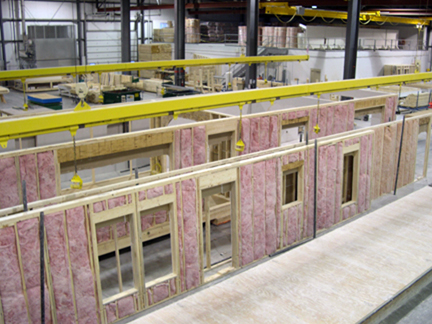We can't all give each other haircuts. We can't all just flip burgers in restaurants. Check out lines are necessary, but we can't all be in retail stores. Someone has to produce something! Producing nations – be it production in agricultural, energy, raw materials as well as goods (i.e.: manufacturing and building) – are historically more powerful, more independent than non-producing nations.
 So while you can have "a service economy," in fact, the service economy over time compared to a production economy – all things being equal – will tend to see the producing nation gaining in wealth and power.
So while you can have "a service economy," in fact, the service economy over time compared to a production economy – all things being equal – will tend to see the producing nation gaining in wealth and power.
To be sure, this is an over-simplification, one designed to make a point. There are other factors, such as the political system one works in. Part of what made America great and so rapidly growing after the Revolution was our freedom, relatively lower taxation and less corruption than many other nations.
The point is that production is necessary for 'the wealth of a nation' and its people! Sure we need teachers, doctors, nurses and scientists. We also need people who build homes, buildings, cars, computers, shoes, clothing and those who produce on a farm, ranch, etc., etc.. When we have more people making and producing – intellectual production can count too – then we can actually have more people giving haircuts and hamburgers (service jobs), who can make more money doing it.
What does this have to do with marketing modular and manufactured housing? Plenty! As you will see below.
While America has had a long love affair with the automobile, housing is a far more important part of the U.S. economy than cars. The basics of life are food, clothing and shelter. While transportation is important, you can transport people in many ways. By contrast, housing is necessary for survival.
Potential Market Demand for Housing, Factory Built and other
A smart marketer (or business owner/executive) wants to know many things, including the need for the product or service he or she wants to promote. The marketer also wants to know what the potential demand for the product or service can be. With that in mind, let's take a look at some facts.
On October 9, 2011, we had 312,387,546 Americans according to the U.S. Census Bureau's population clock. More facts:
OCTOBER 2011
One birth every…………………………………………………. 8 seconds
One death every……………………………………………… 12 seconds
One international migrant (net) every……………… 45 seconds
Net gain of one person every………………………….. 13 seconds
Look at the population patterns since 1980:
Year. Population. %/+
1980 226,545,805 11.5%
1990 248,709,873 9.8%
2000 281,421,906 13.2%
2010 308,745,538 9.7%
What does all this mean? By July 1, 2030, the United States Census Bureau says we will have a population of 363,584,435, less current population of 312,387,546 yields a net gain of an estimated 51,196,889.
Using the current 2.57 people per household, we will need 19,920,968 new housing units by 2030, PLUS the need for the number of homes that will be retired or lost due to fire, natural disaster, deterioration and similar factors.
If manufactured housing captured an average of 20% of this market need for housing, we would have to build 3,984,194 homes by 2030. This is roughly what the Industry has averaged in as our housing market share in the past 20 years, so this is not an unrealistic number.
That is 209,694 homes a year. That's roughly 4 times what we are currently producing!
We would need to add about 150,000 jobs in factories alone to meet that need.
That would mean whatever your part of the Industry is, you would need to do about 4 times more business, or in the case of manufactured home land lease communities, you would likely be full and adding sites where possible.
Frankly, I believe we should be targeting a lot more than 20% market share. But my point is even at 'historic' levels, those who survive have the opportunity to thrive.
Problems spell opportunity in disguise
Ladies and Gentlemen, we can't get bogged down in thinking about just the current housing downturn and the forclosure glut the media loves to focus on. In fact we are awash in opportunity in the housing business in the U.S. alone. But let's not forget the need for housing in other parts of North and South America. Think about the housing needs of Asia (where 60% of the world's population currently lives), or Africa, Europe, Oceania and the rest of the world. We could be shipping homes overseas, IF we get our 'act' together as rapidly as possible.
With incomes down and population rising, American home building – in factories! – offers a huge opportunity. Energy and other sectors of the economy are important, but we are in some phase of the factory home building industry and we can uniquely able to serve every part of the population.
A smart business professional should think about a two parallel paths to present and future success.
Path 1: A Plan to grow your businesses' share of your location's housing market.
Plan 2: A Plan to advance the image, acceptance and thus marketing potential of factory built homes.
To summarize, the facts support the reality that housing is heading for a boom. With so many site builder's decimated and out of business, manufactured and modular construction may be uniquely well poised to take advantage of that coming boom. 300 factories now shuttered in the last 12 years could rapidly be tooled up and re-opened.
But we have to deal with and implement a marketing and image program in order to achieve that potential!
Path 1 is the subject of our popular Dominate Your Local Market Seminar that was presented at the recent Texas Manufactured Housing Association and New York Housing Association annual meetings. It is supported by the Attracting More Customers with Good Credit Seminar that will be presented Wednesday, October 19th at the Indiana Manufactured Housing Association's annual meeting. If you are planning to attend, please say hello after the presentation and share your feedback.
Path 2 are reason we should be pursing the MH Alliance/Phoenix project, so we can boost sales and improve results now, and continue to do so on into the future. Read a news story about the project here.
To learn how we can help boost your marketing and business results now, click here.# #
blog post written by
L. A. 'Tony' Kovach
http://www.linkedin.com/in/latonykovach

